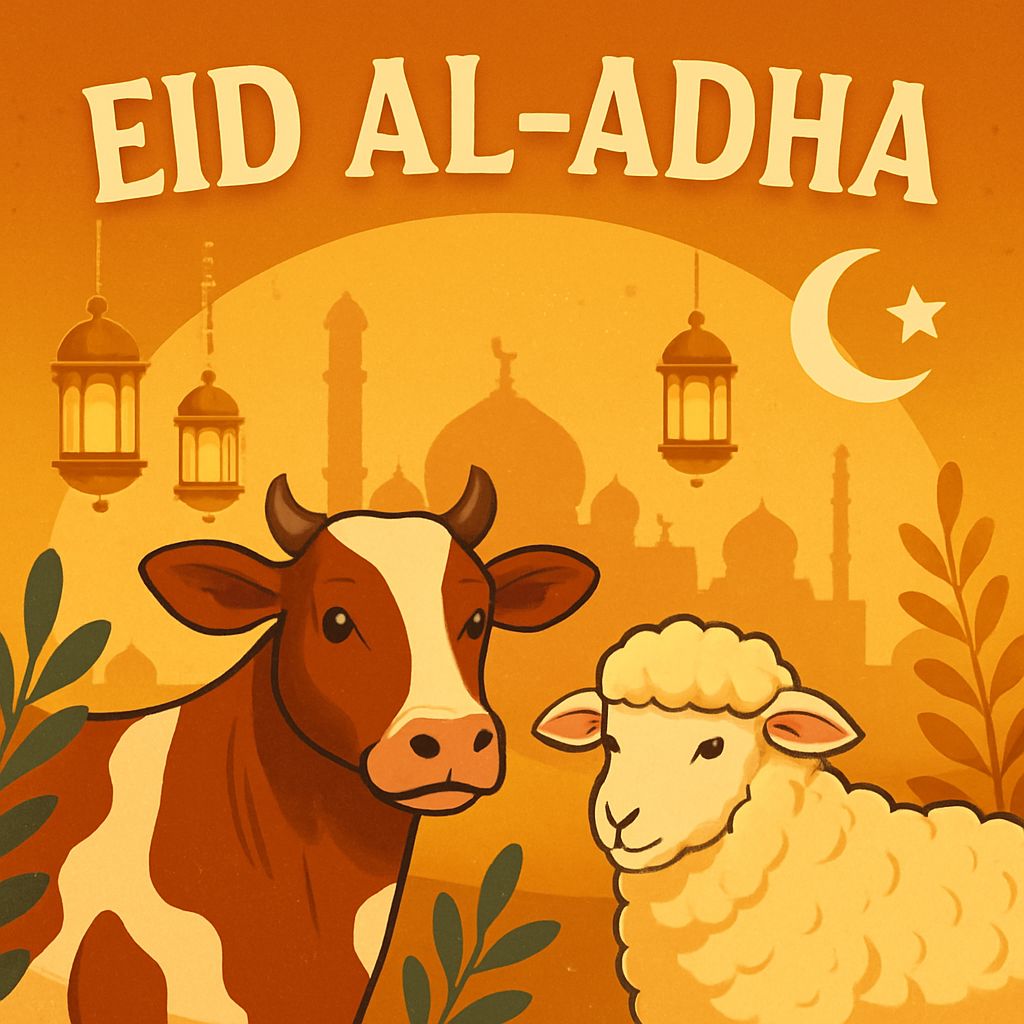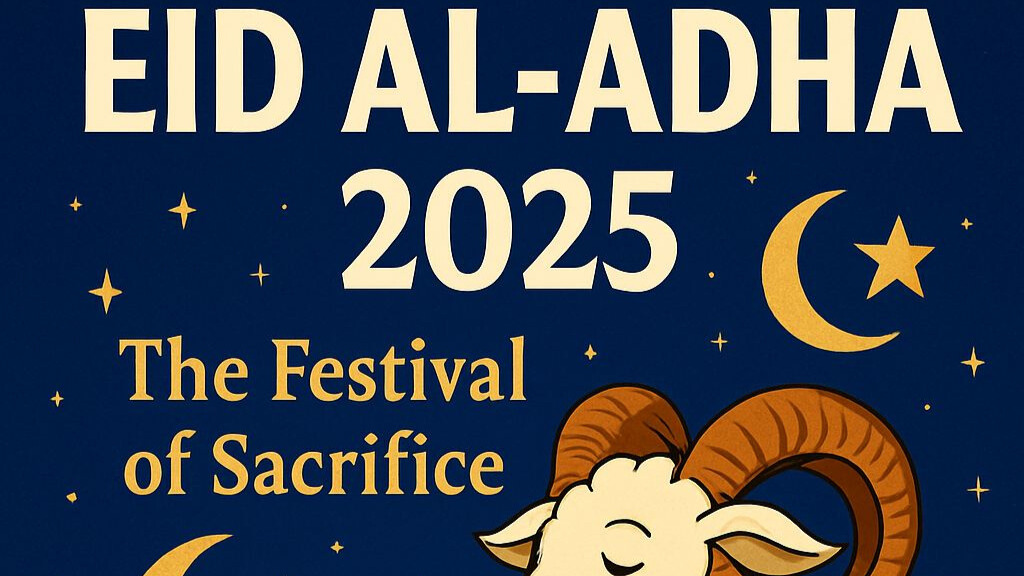Eid al-Adha 2025: The Festival of Sacrifice – A Complete Guide to Islam’s Most Sacred Celebration
Table of Contents
Eid al-Adha, known as the “Festival of Sacrifice,” stands as one of the most significant and sacred celebrations in the Islamic calendar. This blessed occasion commemorates the unwavering faith and obedience of Prophet Abraham (Ibrahim in Arabic) and marks the culmination of the annual Hajj pilgrimage to Mecca. For Muslims worldwide, Eid al-Adha represents the ultimate expression of devotion, sacrifice, and submission to Allah’s will.
As we approach Eid al-Adha 2025, millions of Muslims across the globe prepare for this momentous celebration that unites the Islamic community in prayer, reflection, and acts of charity. This comprehensive guide explores the deep spiritual significance, historical background, and essential rituals that define this holy festival. For the latest updates on Islamic celebrations and community events, visit our trending news section.
What is Eid al-Adha?
Eid al-Adha (عيد الأضحى) literally translates to “Festival of the Sacrifice” in Arabic. It is the second of two major Islamic holidays celebrated by Muslims worldwide, following Eid al-Fitr. This four-day celebration occurs during the Islamic month of Dhul Hijjah and coincides with the completion of the Hajj pilgrimage.
The festival centers around the act of Qurbani (sacrifice), where Muslims who are financially able sacrifice an animal—typically a goat, sheep, cow, or camel—to commemorate Abraham’s willingness to sacrifice his son Ishmael as an act of obedience to God. This ritual symbolizes the believer’s readiness to give up their most precious possessions for Allah and to help those in need.
Eid al-Adha is considered the holier of the two Eids and is often referred to as “Eid al-Kabir” (the Greater Eid) due to its profound spiritual significance and connection to the Hajj pilgrimage.
Eid al-Adha 2025 Date
(Dates may vary by 1-2 days depending on lunar sighting)
The exact date of Eid al-Adha depends on the sighting of the new moon, as the Islamic calendar follows the lunar cycle. The festival begins on the 10th day of Dhul Hijjah, the twelfth and final month of the Islamic lunar calendar. Since the lunar year is approximately 11 days shorter than the solar year, Islamic holidays shift earlier each year in the Gregorian calendar.
Muslims around the world look to religious authorities and moon sighting committees in their respective countries to confirm the official start date, which may vary by one day between different regions. Stay updated with the latest breaking news for official date confirmations from religious authorities.
Historical Significance & The Story of Prophet Abraham
The Divine Test of Abraham
The story of Eid al-Adha traces back over 4,000 years to Prophet Abraham (Ibrahim), who is revered as the father of monotheistic faith. According to Islamic tradition, Abraham received a divine command in a dream to sacrifice his beloved son Ishmael (Ismail) as a test of his faith and obedience to Allah.
Despite the immense emotional pain this command caused, Abraham demonstrated unwavering faith and prepared to carry out God’s will. His son Ishmael, showing equal devotion, willingly agreed to be sacrificed. However, as Abraham raised the knife, Allah intervened and provided a ram to be sacrificed instead, having been satisfied with Abraham’s demonstration of absolute faith.
This pivotal moment established the principle that Allah does not desire human sacrifice but rather complete submission and willingness to surrender everything for His sake. The event became the foundation for the annual commemoration of Eid al-Adha. According to Britannica’s comprehensive guide, this story is central to understanding the theological foundations of the festival.
Why Eid al-Adha is Important in Islam
Eid al-Adha holds profound significance in Islamic theology and practice for several essential reasons:
Spiritual Significance:
- Complete Submission to Allah: The festival embodies the core Islamic principle of surrendering one’s will entirely to Allah, as demonstrated by Abraham’s readiness to sacrifice his most precious possession.
- Renewal of Faith: It serves as an annual reminder for Muslims to examine their own faith and willingness to prioritize Allah’s commands above personal desires and attachments.
- Unity of the Ummah: The simultaneous celebration by Muslims worldwide strengthens the bonds of Islamic brotherhood and reinforces the global Muslim community’s shared values.
- Spiritual Purification: The act of sacrifice is believed to purify the soul and bring the believer closer to Allah through the demonstration of piety and generosity.
- Connection to Hajj: For those not performing Hajj, Eid al-Adha allows participation in the spiritual benefits and blessings associated with this sacred pilgrimage. The Islamic Society of North America provides detailed insights into this spiritual connection.
The Hajj Pilgrimage Connection
Eid al-Adha is intrinsically linked to the Hajj pilgrimage, one of the Five Pillars of Islam. The festival occurs simultaneously with the culmination of Hajj rituals, creating a powerful spiritual connection between pilgrims in Mecca and Muslims worldwide.
What is Hajj?
Hajj is the annual Islamic pilgrimage to Mecca, Saudi Arabia, which every adult Muslim who is physically and financially capable must undertake at least once in their lifetime. It occurs during the Islamic month of Dhul Hijjah and involves a series of ritual acts of worship. According to the Saudi Embassy’s official information, over 2 million pilgrims participate annually.
Key Hajj Rituals During Eid al-Adha:
- Day of Arafat (9th Dhul Hijjah): Pilgrims gather at the Plain of Arafat for prayer and supplication, considered the most important day of Hajj.
- Stoning of the Devil (10th-13th Dhul Hijjah): Pilgrims throw stones at pillars representing Satan, symbolizing the rejection of evil and temptation.
- Sacrifice at Mina: Pilgrims perform the ritual sacrifice, commemorating Abraham’s sacrifice, which coincides with Eid al-Adha celebrations worldwide.
- Tawaf al-Ifadah: Pilgrims perform circumambulation around the Kaaba as part of their Hajj completion.
The timing of these rituals with Eid al-Adha creates a profound spiritual synchronicity, where pilgrims performing Hajj and Muslims worldwide participate in parallel acts of worship and sacrifice.
Essential Rituals Muslims Perform on Eid al-Adha
Traditional Eid al-Adha Observances:
- Early Morning Prayer (Salat al-Eid): Muslims attend special Eid prayers at mosques or designated prayer grounds, typically held shortly after sunrise. This congregational prayer includes specific supplications and is followed by a sermon (khutbah).
- Ritual Sacrifice (Qurbani/Udhiya): Those who are financially able perform the sacrifice of a permissible animal (sheep, goat, cow, or camel). The meat is typically divided into three parts: one-third for the family, one-third for relatives and friends, and one-third for the poor and needy.
- Takbir Recitation: Muslims recite special prayers called Takbir throughout the Eid period, beginning from Fajr prayer on the 9th of Dhul Hijjah until Asr prayer on the 13th of Dhul Hijjah.
- Charity and Giving: Increased charitable giving and helping those in need is emphasized, ensuring that everyone can participate in the joy of the celebration. Learn more about community welfare initiatives in our health and community section.
- Family Gatherings: Muslims gather with family and friends to share meals, exchange gifts, and strengthen social bonds. Traditional foods are prepared and shared as part of the celebration.
- Visiting Relatives: It is traditional to visit family members, especially elders, and seek forgiveness and blessings.
- Wearing New Clothes: Muslims traditionally wear their finest clothes or purchase new garments for the occasion as a sign of celebration and renewal.
Why Muslims Go to Mecca During Dhul Hijjah
Mecca holds unparalleled significance in Islam as the holiest city and the birthplace of Prophet Muhammad. During the month of Dhul Hijjah, millions of Muslims journey to Mecca for several profound reasons:
Religious Significance of Mecca:
The Sacred Kaaba: At the heart of Mecca stands the Kaaba, a cube-shaped structure that serves as Islam’s most sacred shrine. Muslims around the world face toward the Kaaba during their five daily prayers, making it the spiritual center of the Islamic world. The Islamic Organization provides detailed historical context about this sacred site.
Historical Connection: Mecca is believed to be the site where Abraham and Ishmael built the first house of worship dedicated to the worship of one God. This connection links contemporary Muslims directly to the prophetic traditions.
Pilgrimage Obligation: The Hajj pilgrimage to Mecca during Dhul Hijjah is one of the Five Pillars of Islam, making it a religious obligation for every Muslim who is physically and financially capable.
Spiritual Transformation: The journey to Mecca represents a spiritual homecoming and an opportunity for complete spiritual renewal, forgiveness, and purification.
Unity of the Ummah: The gathering of millions of Muslims from diverse backgrounds in Mecca demonstrates the unity and equality of all believers before Allah.
Eid al-Adha Celebration Traditions Worldwide
While the core religious observances remain consistent, Eid al-Adha celebrations incorporate rich cultural traditions that vary across different Muslim communities worldwide:
Common Celebration Elements:
- Festive Meals: Families prepare elaborate feasts featuring traditional dishes, with the sacrificial meat often serving as the centerpiece of the celebration.
- Gift Giving: Exchange of gifts, especially to children, is common in many cultures, symbolizing joy and blessing.
- Community Gatherings: Mosques and community centers often organize special events, lectures, and communal meals to bring the community together.
- Decorations: Homes and mosques are decorated with lights, banners, and Islamic calligraphy to create a festive atmosphere.
- Traditional Greetings: Muslims exchange greetings such as “Eid Mubarak” (Blessed Eid) or “Eid Sa’eed” (Happy Eid) to share in the joy of the occasion.
Regional Variations:
Different Muslim cultures have developed unique traditions while maintaining the festival’s core spiritual significance. From the elaborate preparations in South Asia to the community celebrations in the Middle East and the growing traditions in Western Muslim communities, Eid al-Adha reflects the beautiful diversity within Islamic unity. For coverage of cultural celebrations and community events, check our entertainment and culture section.
Embracing the Spirit of Sacrifice and Faith
Eid al-Adha 2025 offers Muslims worldwide an opportunity to reconnect with their faith, strengthen family bonds, and demonstrate compassion for those in need. This sacred festival reminds us that true devotion lies not merely in ritual observance but in embodying the spirit of sacrifice, generosity, and submission to Allah’s will in our daily lives.
As we celebrate this blessed occasion, may it inspire us to follow the example of Prophet Abraham and deepen our commitment to faith, charity, and service to humanity. For more updates on religious observances and community events, continue following Kashmir News.



